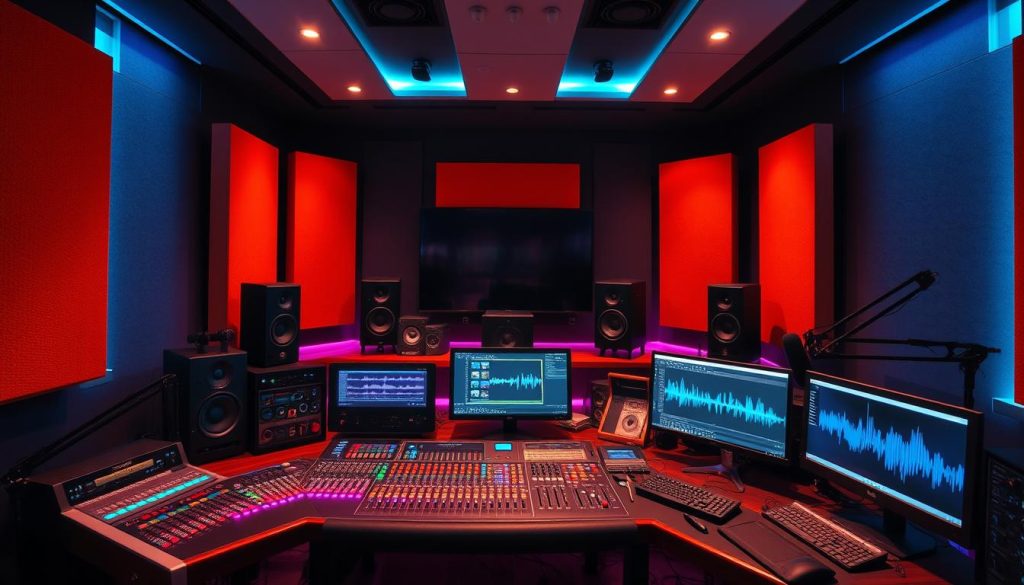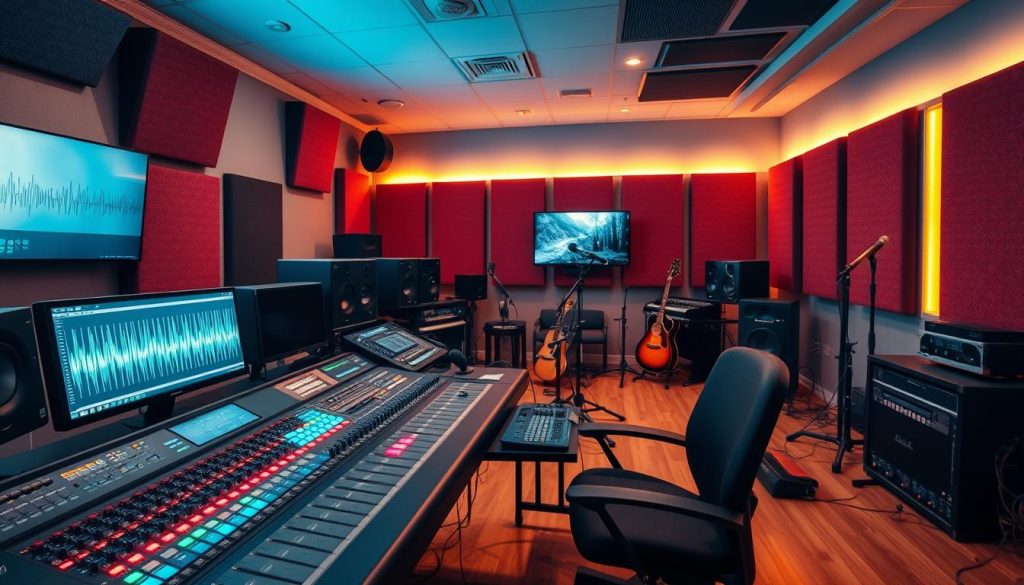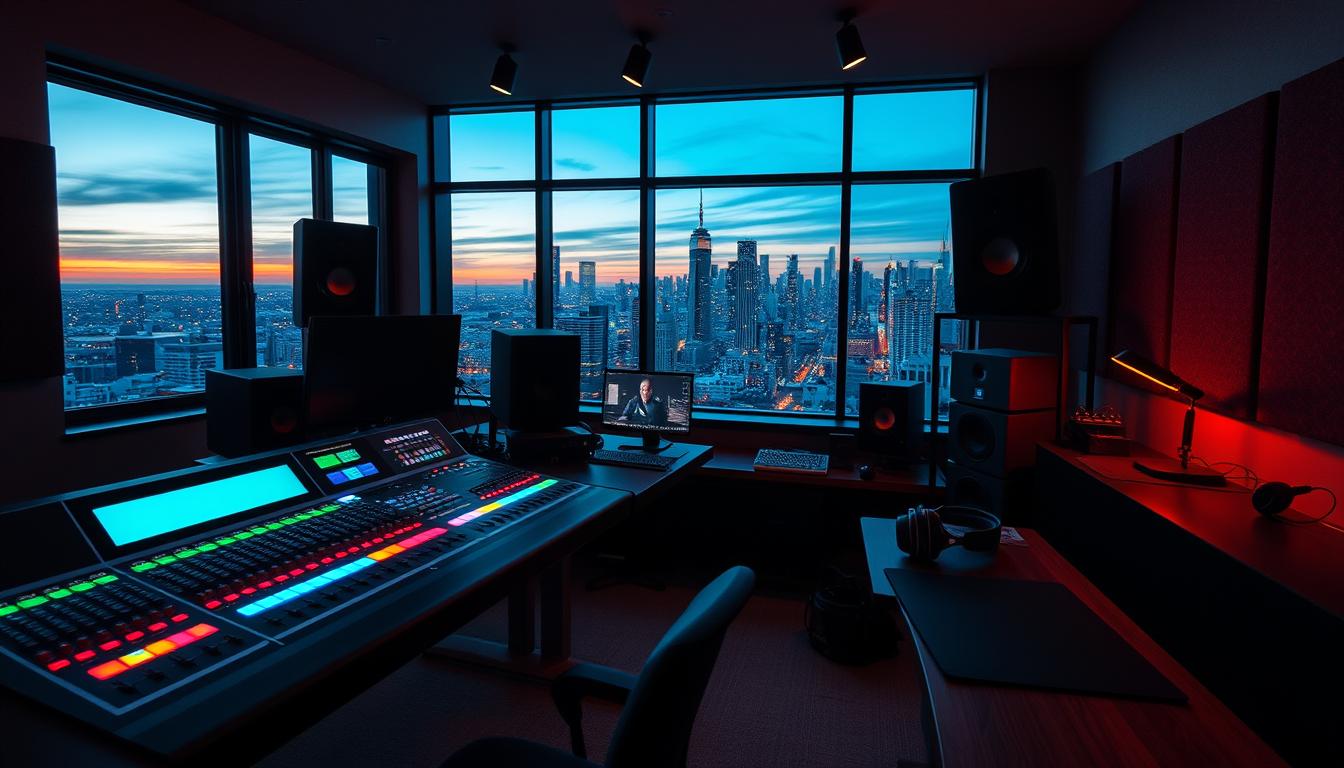As a music lover, I know how key sound mixing is. It turns raw tracks into something professional. Mixing is all about balance and making the music pop. Learning sound mixing can make your music stand out.
This article will help you learn how to mix music well. I’ll share tips to avoid mistakes and improve your music. It’s great for both new and experienced audio engineers. Knowing the basics of sound mixing, audio production, and music mixing techniques is key to a great mix.
Let’s explore audio engineering together. We’ll learn how to boost your mixing techniques. This will help you make music that grabs listeners.
Overview of Basic Audio Mixing Techniques
Mixing audio means blending tracks together smoothly. As an engineer, I’ve found it key to know the basics well. This part covers the main techniques for great sound mixing.
Balancing Volume and Gain Staging
First, make sure the volume is right and the gain is set correctly. Keep the signal below 0 dBFS to avoid distortion. It’s important to balance the volumes of each track. This makes sure everything sounds good together.
Panning and Stereo Imaging
Panning helps create a wide sound. Place tracks across the stereo field to avoid sound overlap. Keep important sounds like vocals and bass in the middle. Spread out other sounds for a full, three-dimensional sound.
Equalization and Frequency Balance
EQ is key in mixing, letting you make space for each track in the sound spectrum. Adjusting frequencies helps avoid sound overlap. Use subtractive EQ to clean up the mix and get the right sound balance.
| Technique | Description | Key Benefits |
|---|---|---|
| Volume Balancing | Adjusting the levels of individual tracks to create a cohesive blend | Ensures each element is clearly audible without overshadowing others |
| Gain Staging | Setting the optimal gain levels to maintain a clean, undistorted signal | Preserves headroom and clarity in the mix |
| Panning | Positioning elements across the stereo field to create depth and separation | Prevents frequency clashes and enhances the overall spatial image |
| Equalization (EQ) | Boosting or cutting specific frequencies to balance the mix | Carves out a distinct space for each track and prevents masking |
Learning these basic mixing techniques will help you make great mixes. Keep following for the next part. We’ll talk about the gear and software you need for top-notch audio production.
Essential Mixing Equipment and Software
To make your audio production better, you need the right gear and software in your home studio. A reliable computer and a DAW like Pro Tools First, FL Studio, or Logic Pro are key. These tools let you record, edit, and mix your audio tracks well.
You also need studio-grade headphones and speakers to listen to your mixes. High-quality gear helps you hear every detail. You’ll use plugins and audio effects too, like equalizers and reverb, to improve your tracks.
Getting the right equipment and software is the first step to making professional sound on a budget. With the right tools, you can make the perfect mix.
Recommended Home Studio Equipment and Software
- Computer (desktop or laptop)
- Digital Audio Workstation (DAW) – e.g., Pro Tools First, FL Studio, Logic Pro
- Studio-grade headphones
- Studio monitors (speakers)
- Audio interface
- Microphone
- Mixing plugins (equalizers, compressors, reverb, delay, etc.)
| Item | Recommended Models | Approximate Cost |
|---|---|---|
| Computer | Apple MacBook Pro, Dell XPS 15 | $1,000 – $2,500 |
| DAW Software | Pro Tools First, FL Studio, Logic Pro | $0 – $300 |
| Studio Headphones | Sennheiser HD 6 Series, Audio-Technica ATH-M50x | $100 – $300 |
| Studio Monitors | Yamaha HS5, KRK Rokit 5 G4 | $200 – $500 per pair |
| Audio Interface | Focusrite Scarlett 2i2, Steinberg UR22 mkII | $100 – $300 |
| Microphone | Shure SM57, Rode NT1 | $100 – $400 |
| Mixing Plugins | Waves, iZotope, Fab Filter | $50 – $500 per plugin |
Understanding the Mixing Process

As a mixing engineer, my main job is to mix different audio tracks into one smooth track. I use sound tools in a Digital Audio Workstation (DAW) and listen carefully. I make sure each sound fits well in the mix without getting too loud.
The Role of a Mixing Engineer
I take the raw recordings and make them sound professional. I adjust the volume, pan, EQ, and add effects. My goal is to make the music sound great and match the artist’s vision.
Organizing Your Workflow
Having a good workflow is key for mixing. I start by organizing tracks in my DAW. This helps me work efficiently, setting levels and adding effects. Keeping tracks organized makes mixing easier and more effective.
Importance of Proper Monitoring
Good monitoring is vital for mixing. High-quality studio monitors let me hear my mix clearly. They give me a true sound, helping me make the right decisions. A clear listening space is important for making a mix that sounds good everywhere.
Sound Mixing Techniques

Learning sound mixing is key to making your audio production stand out. By using advanced techniques, you can shape your tracks and get a pro-sounding mix. We’ll look into mix processing, showing how to blend drums, bass, guitars, and vocals together.
Balancing the Rhythm Section
A great mix starts with the rhythm section. Balance the kick drum and snare so they work well together. Use compression and EQ to make them stand out without drowning the other sounds.
Integrating the Bass Guitar
The bass guitar is crucial for the low end of your mix. It needs a careful touch to fit right in. Use special mixing tricks like parallel compression and EQ to make the bass strong but not too loud.
Sculpting the Guitar and Keyboard Tones
Guitars and keyboards take up a lot of space in a mix. Use sound shaping to make each one clear and distinct. Try different effects like distortion and modulation to make them sound great together.
Positioning the Lead Vocals
The lead vocals are often the main focus. Make sure they’re clear and upfront by adjusting their level and using EQ and compression. Add reverb and delay to make them sound deeper and clearer.
Mastering these advanced mixing techniques will take your audio production to the next level. You’ll get a professional-sounding mix that shows off your music.
Mixing Individual Elements
Mixing each part of your track right is key to a great final sound. I begin with the kick drum, making sure it’s strong in both level and tone. Then, I balance the snare for a clear backbeat. Hi-hats and cymbals add definition.
Next, I work on the bass to match the drums well. I adjust the frequency and level to prevent it from getting muddy. Guitars, keyboards, and other instruments fill out the sound without clashing.
Finally, I place the lead vocals in the mix so they stand out. They should blend well with the other parts. By mixing drums, bass, guitars, and vocals carefully, I get a mix that’s balanced and dynamic. Each instrument gets to show its unique sound and role in the music.

